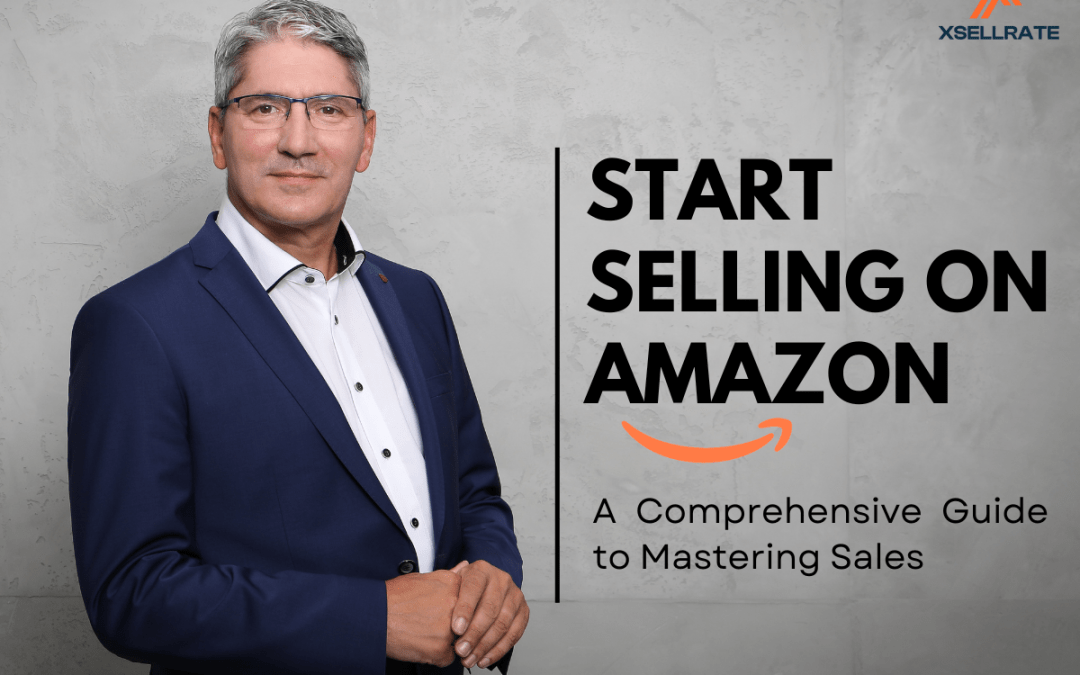Why Sell on Amazon UK?
Selling on Amazon UK opens doors to a broad market, with millions of active shoppers across the country. Amazon is trusted by consumers, and it offers several advantages for sellers, including:
- Massive Customer Reach: Amazon UK is one of the leading e-commerce platforms, providing access to a large, engaged customer base.
- Fulfillment by Amazon (FBA): FBA allows you to offload inventory storage, packaging, and shipping responsibilities to Amazon, letting you focus on growing your business.
- Global Expansion: By selling on Amazon UK, you can eventually tap into other international marketplaces through Amazon’s Global Selling program.
With the right strategies, you can leverage Amazon’s tools and customer base to achieve substantial growth.
Amazon UK Offers Various Incentives for New Sellers
- Earn 10% cash back on the first £40,000 of branded sales, then 5% cashback until you reach £42,000 in bonus value.
- Receive £80 in credit for shipments into Amazon’s fulfilment network via the Amazon Partnered Carrier program, or £160 in credit towards fulfillment expenses with Amazon Global Logistics.
- Enjoy free storage and customer returns with automatic enrolment in the FBA New Selection program, if you choose FBA.
- Additional credits: £160 for Amazon Vine customer reviews*, £40 for Sponsored Products ads, and £40 for Amazon Vouchers.
Choosing Your Fulfilment Method: FBA vs FBM
When it comes to fulfilment, you have two main options: FBA (Fulfilled by Amazon) or FBM (Fulfilled by Merchant).
1. FBA (Fulfilled by Amazon): Amazon stores, picks, packs, and ships your products, freeing you from the logistics. FBA also gives your products Prime eligibility, which can lead to higher sales due to fast and free shipping. However, there are fees associated with FBA, such as storage and shipping charges.
2. FBM (Fulfilled by Merchant): With FBM, you’re responsible for storing, packing, and shipping your products. This method gives you more control over inventory and shipping but requires more work on your part.
If you’re just starting, FBA can be a great way to streamline operations, while FBM is suitable for those who want more control over their business.
Read Related Blog: FBA vs FBM: Choose Right Amazon Fulfillment & Know Fees
Understanding UK Tax Requirements for Selling on Amazon
As an Amazon seller in the UK, you’ll need to comply with VAT (Value Added Tax) regulations. If your sales exceed the VAT registration threshold (£85,000), you’ll need to register for VAT with HMRC.
1. VAT Calculation Service: Amazon offers a service to help calculate VAT for your sales.
2. Tax Returns: Keep track of your sales and expenses to ensure you’re accurately reporting your earnings.
Let’s Delve into the Process of Amazon Seller Account Setup
Getting started on Amazon UK is straightforward. Here’s a step-by-step guide:
Step 1: Go to Amazon Seller Central here and click on “Sign Up.”

(Credit: Amazon UK)
Step 2: Create an Account
You’ll need to register with basic details such as your business name, credit card, passport, address, contact information, and tax identification number (VAT, if applicable). For UK-based businesses, having a UK bank account and a VAT registration number may be required.
Step 3: Choose Your Selling Plan (Individual vs. Professional)
As a new seller, you’ll need to decide between the Individual or Professional seller plans. Here’s a quick comparison:
A. Individual Account:
Best for sellers who are just starting and have limited inventory. There are no monthly fees, but you’ll be charged £0.75+VAT per item sold. This plan is perfect if you’re testing the waters or selling a small number of items each month.
B. Professional Account:
Ideal for businesses that plan to scale quickly or have a large inventory. With a Professional account, you pay a fixed monthly fee of £25 + VAT. This plan also offers access to advanced selling tools, reports, and advertising options, making it the go-to choice for serious sellers.
After completing these steps, you’ll be ready to start listing your products!
Read Related Blog: Choosing the Right Amazon Seller Plan: Individual vs. Professional
Step 4: Listing Your Products on Amazon UK
Once your amazon seller account setup is done, it’s time to list your products. There are two ways to do this:
A. Use the Amazon Catalogue
If your product is already listed on Amazon, you can simply match it with the existing product details. This saves you time and ensures consistency.
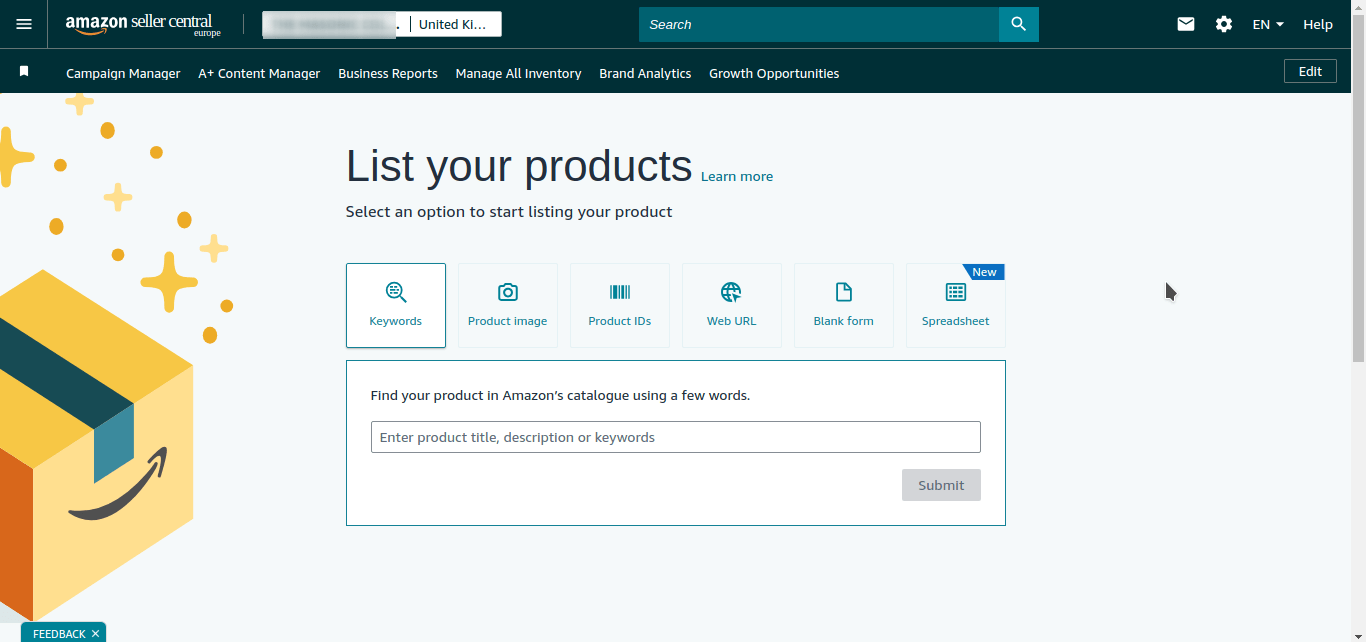
(Credit: Amazon UK)
If you’re selling a unique or unlisted product, you’ll need to create a new listing. Provide key details such as product name, description, brand, and manufacturer. Add high-quality images and choose the correct category for your product.
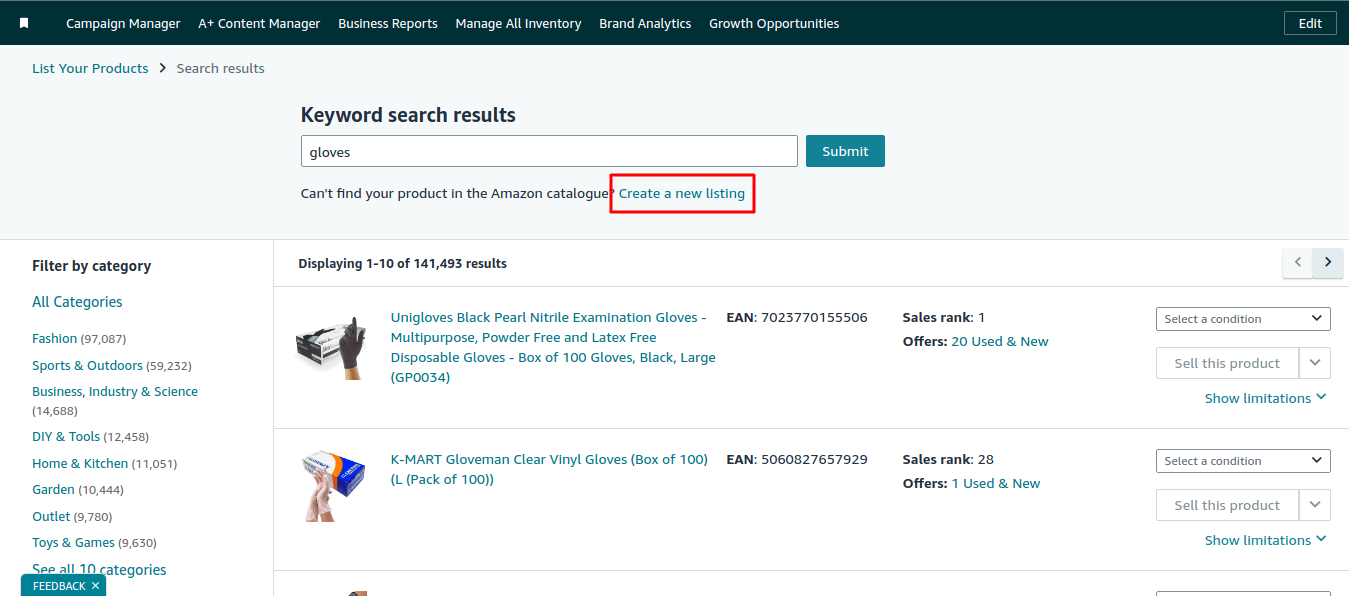
Enter your product name, and the most relevant product types will appear. If you believe the suggested product type is appropriate, you can select it, or you have the option to choose the correct product type yourself.
Read Related Blog: The Ultimate Guide to Amazon Product Research: Finding Winning Products
(Credit: Amazon UK)
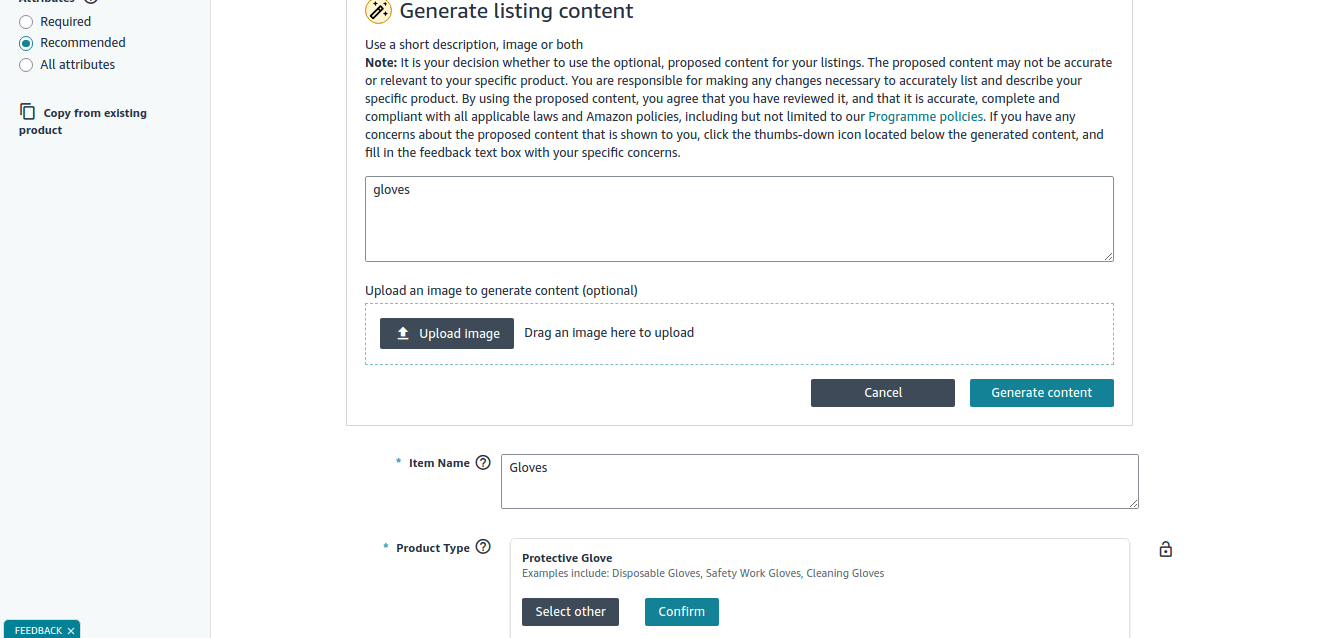
(Credit: Amazon UK)
1. Product Identity
2. Description
3. Product Details
4. Offer
5. Safety & Compliance
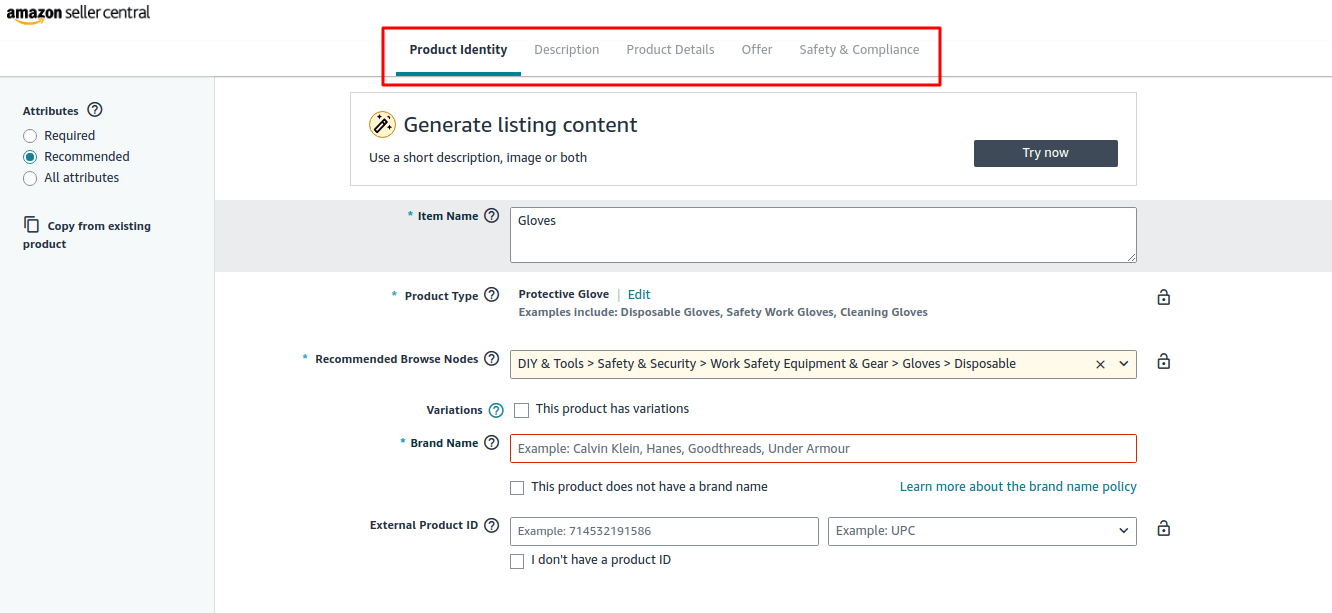
(Credit: Amazon UK)
Here Are a Few Tips for Creating a Compelling Product Listing:
A. Optimize Your Title: Use keywords that shoppers are likely to search for. Keep it clear and descriptive.
B. Write Detailed Descriptions & Bullets: Include important features, specifications, and benefits that will help buyers make an informed decision.
C. Use High-Quality Images: Amazon has specific guidelines for product images, including size, background, and clarity. Great photos can make a significant difference in driving sales.
Pricing Your Products
Pricing is one of the most crucial factors when selling on Amazon UK. Here are a few things to consider:
1. Research Competitors: Check what similar products are priced at to ensure you remain competitive.
2. Amazon Fees: Factor in Amazon’s referral fees (which can range from 6% to 45% depending on the product category) and other charges like FBA fees if you use Amazon’s fulfilment services.
Check Amazon referral fees here: https://sell.amazon.co.uk/pricing?ref_=sduk_soa_prirf_n#referral-fees.
3. Profit Margins: Always keep your costs in mind. While it’s tempting to offer lower prices, make sure you’re still making a profit after fees and shipping costs.
4. Automated pricing tool: Amazon also offers an automated pricing tool that can help you adjust your prices based on competition, making it easier to stay competitive.
Managing Inventory and Order Fulfilment
Effective inventory management is key to maintaining a smooth operation. Use Amazon’s inventory management tools to track stock levels, set up alerts for low stock, and prevent overstocking.
1. Stock Alerts: Amazon provides alerts when your stock is running low. This helps you avoid running out of inventory.
2. Restocking Reminders: Keep track of your products and replenish stock in time to meet demand.
Efficient fulfilment and timely order shipping are essential for maintaining a positive seller rating and ensuring customer satisfaction.
Amazon Seller Fees in the UK
When selling on Amazon UK, understanding the fees is crucial for pricing your products accurately. Here are the main fees to consider:
1. Referral Fees: A percentage of each sale, varying by category. For example, books have a lower fee, while electronics may have a higher referral fee. Check referral fees here.
2. Subscription Fees: £25 + VAT per month for a Professional seller account. Explore subscription fees here.
3. FBA Fees: If you choose Fulfilled by Amazon, there are fees for storage, picking, packing, and shipping. Check FBA fees here.
4. Closing Fees: For media products (e.g., books, DVDs), Amazon charges a closing fee.
It’s important to factor these fees into your product pricing to ensure your profitability.
Promoting Your Products on Amazon UK
To increase your visibility and sales, you’ll need to promote your products. Amazon offers several advertising tools that can help:
1. Sponsored Products: Advertise individual products in search results to drive traffic.
2. Sponsored Brands: Create brand awareness by promoting your entire brand or a selection of products.
3. Amazon Promotions: Offer discounts, deals, and vouchers to entice customers.
Ensure your PPC campaigns are optimized with effective strategies to avoid unnecessary spending and minimize losses. Contact us for expert management of your PPC campaigns, delivering a great ROI and helping your sales skyrocket.
Handling Customer Service and Reviews
Encouraging positive reviews is essential for building trust with your customers. Always ask satisfied customers to leave feedback. However, handle negative reviews constructively by addressing the issue and offering a solution.
Conclusion
Starting your Amazon UK business may seem like a daunting task, but with the right approach and the right tools, success is within reach. Follow this guide to amazon seller account setup, list products, and scale your business. The opportunities are endless – get started today and join the millions of sellers thriving on Amazon UK!
If your goal is to scale your business, let us manage your entire Amazon account—from product listings to PPC campaign management. Our expert team will take care of everything for you. Visit Xsellrate Tools to discover our proven strategies and outstanding results.

